Sockets and plugs in the countries
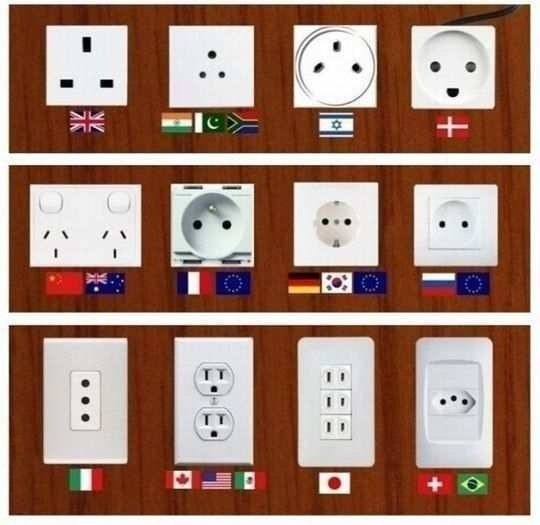
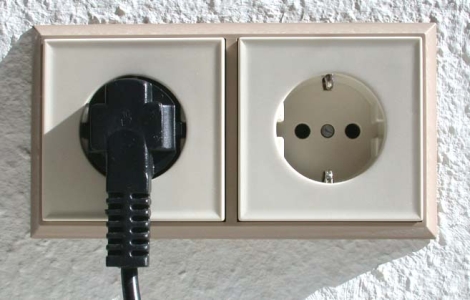
Plug connectors (from it Stopsel - cork) - a device for the electrical connection of electrical appliances to the electrical network. The plug connection consists of two parts: sockets and plugs.
A socket outlet is a part of a connector to which electrical energy is supplied from a source. The Russian name comes from a widespread decoration. To prevent contact with foreign objects, the socket is designed as a female connector.
Plug - part of the connector for connecting the consumer of electricity to the outlet. The electrical contacts of the plug are usually in the form of pins, which give it some similarity to the dining fork, which is why the Russian name came about. Can be connected to an electrical appliance by a flexible cable (cord), or be fixedly fixed on it.
Dissemination of standards
Wide use of electricity in everyday life is impossible without the development of appropriate standards. Standardization of wiring accessories made it possible to make the use of electricity safer, appliances - more reliable, inexpensive and massive. However, often standards in different countries were developed independently of each other, which led to their great diversity and incompatibility with each other. Some standards were not widely used and disappeared. As a result of the influence of economic and political factors, some countries have changed their standards. Hotels and airports for convenience of travelers can have sockets of foreign standards. In some countries, several connection, voltage and frequency standards can simultaneously be used, which often leads to problems.
Combining standards
In recent years, many countries have agreed on a few de facto standards that have formally become official national standards, although in many countries connectors of obsolete types are still used. Some buildings have wiring, which has been used for about a century, which was carried out before the introduction of modern standards.
Steps were taken to unite the standards of different countries. For example, the CEE 7/7 plug is adopted in some European countries and is compatible with the types of sockets E and F, while the unpolarized plug CEE 7/16 (Eurovilk) is compatible with sockets in most of continental Europe, the former USSR and many others Countries. The standard IEC 60906-1 is proposed as a common standard for all 230-volt plugs and sockets worldwide, but so far it has only been adopted in Brazil.
Many manufacturers of electrical appliances, such as personal computers, have adopted the practice of using an interchangeable cord, connected to the IEC connector. For each country the device is equipped with a different cord, while the remaining parts remain unchanged. To select the voltage and frequency standards, a switch is installed, and sometimes the device is also calculated for operation over a wide range of network voltages, which became possible with the use of switching power supplies. The practical benefit of this approach is in simplifying certification, as well as in the release of one device, instead of several for each standard.
Standards of different countries
In the world, the two most common voltage and frequency standards are most common. One of them is American standard 110-127 Volts 60 Hertz, together with plugs A and B. The other standard is European, 220-240 Volts 50 Hertz, plugs of C-M types. Most countries adopted one of these two standards, although in some cases There are transitional, or unique standards. The maps show which countries use certain standards.
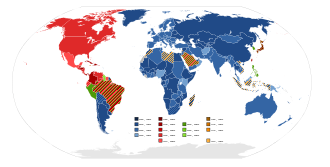 Voltage and frequency. Blue - 220/50, green - 220/60, yellow - 110/50, red - 110/60 |
 Types of plugs. |
Summary table of the types of household plugs, sockets, the rating of the supplying electrical single-phase voltage and the frequency of the network in the countries of the world.
Nominal values of electrical networks. Manual for determining the types of plugs and sockets that you have.
| A type | A photo | Explanations |
A
|
|
Type A
Type A plugs are compatible with type B outlets. Polarized and unpolarized type A plugs are available. Type A polarized plugs are not included in unpolarized type A outlets because both slots in the outlet are equally narrow. However, unpolarized and polarized type A plugs are included in a polarized Type A and Type B outlets. Japanese plug and socket are identical to type NEMA 1-15. Many Japanese sockets and multi-wire adapters are unpolarized - cracks in sockets of the same size - and accept only unpolarized plugs. Japanese plugs generally approach to most North American outlets without problems, but a polarized North American plug may require an adapter or replacement to connect to old Japanese outlets. |
B
|
|
Type B
A type B plug has, in addition to parallel flat knives, a round, or a U- shaped ground contact. Sometimes both feed contacts in type B forks are narrow, because the plug can not be turned on incorrectly due to the grounding contact, but the slots in the outlet have different sizes for proper connection of the type A plugs. Not always 20 and 15 ampere plugs and sockets coincide (but Often this is so). |
FROM
|
|
This FLAT fork is designed for a current of 2.5 A. Since it is unpolarized, it can be inserted into the outlet in any position, so the phase and the neutral are connected at random. The spacing and length of the pins make it safe to plug it into most outlets CEE 7/17 type C, type E, type H, CEE 7/4 (Schuko) type F, CEE 7/7 type E / F, type J, type K and type L (L10 ampere).
This plug also has two round pins, but they have a diameter of 4.8 mm, as in types E and F. The plug has a round plastic or rubber base that prevents it from being inserted into the small sockets provided for Europlug. The plug is designed only for large round outlets for types E and F, but can be inserted into a type H outlet, although this is undesirable, since they are designed for pins of smaller diameter. The plug has both a hole for the grounding pin and (sometimes) contact strips for the side contacts. |
С1 / С ussr
|
 |
In the USSR, according to GOST 7396.1-89 there was a standard plug C1, the same as type C, but with pins, 4 mm in diameter. This plug is rated for 6A. In a Soviet rosette eurowatch is difficult to turn on because of the difference in the thickness of the pins. In the Euroset, the Soviet plug is difficult to turn on because the C1 plug has a round base. |
D and M
|
Type D
Type M |
Type D
She has three large round pins, placed along the tops of the triangle. Type M 15-amp version of plug D. In most cases, plugs and sockets D and M are compatible. The pins on the plug D are already pins on the M and this plug can always be pushed into the socket M (will the contact be as lucky), the same plug M can not always be crammed into the outlet D. |
E
|
|
Type E
The socket is not compatible with the plug type F CEE 7/4. The ground in the socket type E is made with a round pin, permanently built into the socket. The plug is round, with two round pins measuring 4.8x19 mm, with a distance between them of 19 mm and a hole for the grounding pin of the socket. The socket fits into the flat plugs type C Europlug 7/16 and CEE 7/17. The plug often fits into other types of sockets, when using force, you can damage the outlet. |
F
|
 |
Type F
Designed for up to 16 amps, unpolarized and accepts Type C and Europlug plugs CEE 7/16 and 7/17. |
E / F
|
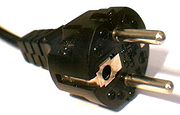 |
Type E / F
The CEE 7/7 plug is compatible with types E and F. Polarized when used with an E type outlet, but in F type receptacles, the phase and neutral wires are not fixed. The plug is designed for 16 A. The grounding clips on both sides for connection to a type F CEE 7/4 socket and the female connector for the grounding pin are type E CEE 7/5. |
G
|
 |
Type G
The fuse in the plug can be inserted either, but for safety reasons it must be rated for the maximum current of the protected device. The fuse has a length of 1 inch (25.4 mm) according to the British standard BS 1362. |
H
|
 |
Type H
Two plugs and one socket, not found anywhere else, except Israel. The plugs are not compatible with other types of sockets. To the majority of sockets type H it is possible to connect plugs of type C. |
I
|
|
Type I
|
J
|
|
Type J SEV 1011 (Swiss type 10 A / 250 V). Suitable for outlets are Swiss plugs or flat Europlug CEE 7/16 type C. |
K
|
 |
Type K Danish 107-2-D1, The socket is suitable for Danish plugs, it is possible to insert plugs of type C CEE 7/16 or CEE 7/17, type E / F CEE7 / 7 and type F CEE 7/4 (Schuko). The plugs almost do not fit anywhere. |
L
|
|
Type L - central pin - ground
A 10 amp outlet (it is smaller) includes a flat type C plug (CEE 7/16)
Does not fit anywhere else. |
M
|
See type D | |
Supply voltage and applicable types of sockets and plugs for the countries of the world.
| Countries and territories | Socket type | Single-phase voltage | Network Frequency | Note (we will gladly include your comments) | |
| Australia | I | 230 V | 50 Hz | ||
| Austria | C, F | 230 V | 50 Hz | ||
| Azerbaijan | C | 220 V | 50 Hz | ||
| Azores | C, F | 220 V | 50 Hz | ||
| Albania | C, F | 220 V | 50 Hz | ||
| Algeria | C, F | 230 V | 50 Hz | ||
| American Samoa | A, B, F, I | 120 V | 60 Hz | ||
| Anguilla | A, B | 110 V | 60 Hz | ||
| Angola | C | 220 V | 50 Hz | ||
| Andorra | C, F | 230 V | 50 Hz | ||
| Antigua | A, B | 230 V | 60 Hz | At the airport 110 V | |
| Macau (Macao) | D, M, G, rarely F | 220 V | 50 Hz | ||
| Argentina | C, I | 220 V | 50 Hz | ||
| Armenia | C, F | 220 V | 50 Hz | ||
| Aruba | A, B, F | 127 V | 60 Hz | In Lago 115 In | |
| Afghanistan | C, D, F | 240 V | 50 Hz | Meets anything | |
| Bahamas | A, B | 120 V | 60 Hz | In some remote regions 50 Hz | |
| Balearic Islands | C, F | 220 V | 50 Hz | ||
| Bangladesh | A, C, D, G, K | 220 V | 50 Hz | ||
| Barbados | A, B | 115 V | 50 Hz | ||
| Bahrain | G | 230 V | 50 Hz | In Avali 110 V, 60 Hz | |
| Belarus | C | 220 V | 50 Hz | ||
| Belize | A, B, G | 110 V, 220 V | 60 Hz | ||
| Belgium | C, E | 230 V | 50 Hz | ||
| Benin | C, E | 220 V | 50 Hz | ||
| Bermuda | A, B | 120 V | 60 Hz | ||
| Bulgaria | C, F | 230 V | 50 Hz | ||
| Bolivia | A, C | 220 V | 50 Hz | In La Paz 115 V | |
| Bosnia | C, F | 220 V | 50 Hz | ||
| Botswana | D, G, M | 231V | 50 Hz | ||
| Brazil | A, B, C, I | 127 V, 220 V | 60 Hz | ||
| Brunei | G | 240 V | 50 Hz | ||
| Burkina Faso | C, E | 220 V | 50 Hz | ||
| Burundi | C, E | 220 V | 50 Hz | ||
| Butane | D, F, G, M | 230 V | 50 Hz | ||
| Vanuatu | I | 230 V | 50 Hz | ||
| Great Britain (England, Britain, United Kingdom) | G, is much rarer than D and M | 230 V | 50 Hz | Previously 240 V; Sometimes an additional low-voltage (110-115 V) socket in the bathroom, similar to type C | |
| Venezuela | A, B | 120 V | 60 Hz | It is also possible to have 220 V with type G for supplying air conditioners, etc. | |
| Hungary | C, F | 230 V | 50 Hz | Previously 220 V | |
| East Timor | C, E, F, I | 220 V | 50 Hz | ||
| Vietnam | A, C | 220 V | 50 Hz | Type A - in South Vietnam, type C - in the North. The expensive hotels also use type G | |
| Gabon | C | 220 V | 50 Hz | ||
| Haiti | A, B | 110 V | 60 Hz | ||
| Guyana | A, B, D, G | 240 V | 60 Hz | ||
| Gambia | G | 230 V | 50 Hz | ||
| Ghana | D, G | 230 V | 50 Hz | ||
| Germany | C, F | 230 V | 50 Hz | Previously 220 V | |
| Guadeloupe | C, D, E | 230 V | 50 Hz | ||
| Guatemala | A, B | 120 V | 60 Hz | ||
| Guinea | C, F, K | 220 V | 50 Hz | ||
| Guinea-Bissau | C | 220 V | 50 Hz | ||
| Gibraltar | G, K | 240 V | 50 Hz | Type K only in Europort | |
| Honduras | A, B | 110 V | 60 Hz | ||
| Hong Kong | G, M, D | 220 V | 50 Hz | ||
| Grenada | G | 230 V | 50 Hz | ||
| Greenland | C, K | 220 V | 50 Hz | ||
| Greece | C, F | 230 V | 50 Hz | Previously 220 V | |
| Guam | A, B | 110 V | 60 Hz | ||
| Denmark | C, K, E | 230 V | 50 Hz | ||
| Djibouti | C, E | 220 V | 50 Hz | ||
| Dominica | D, G | 230 V | 50 Hz | ||
| Dominican Republic | A, B | 110 V | 60 Hz | ||
| Egypt | C | 220 V | 50 Hz | ||
| Zambia | C, D, G | 230 V | 50 Hz | ||
| Western Samoa | I | 230 V | 50 Hz | ||
| Zimbabwe | D, G | 220 V | 50 Hz | ||
| Israel | C, H, M | 230 V | 50 Hz | ||
| India | C, D, M | 230 V | 50 Hz | ||
| Indonesia | C, F, less often G | 127 V, 230 V | 50 Hz | ||
| Jordan | B, C, D, F, G, J | 230 V | 50 Hz | ||
| Iraq | C, D, G | 230 V | 50 Hz | ||
| Iran | F, less often C | 220 V | 50 Hz | ||
| Ireland | D, F, G, M | 230 V | 50 Hz | Previously 220 V; Sometimes an additional 110 V | |
| Iceland | C, F | 230 V | 50 Hz | ||
| Spain | C, F | 230 V | 50 Hz | Previously 220 V | |
| Italy | C, F, L | 230 V | 50 Hz | Previously 220 V | |
| Yemen | A, D, G | 230 V | 50 Hz | ||
| Cape Verde (Cape Verde Islands) | C, F | 220 V | 50 Hz | ||
| Kazakhstan | C, F | 220 V | 50 Hz | ||
| Cayman Islands | A, B | 120 V | 60 Hz | ||
| Cambodia | A, C, G | 230 V | 50 Hz | ||
| Cameroon | C, E | 220 V | 50 Hz | ||
| Canada | A, B | 120 V | 60 Hz | Sometimes an additional 240 V | |
| Canary Islands | C, E, F, L | 220 V | 50 Hz | ||
| Qatar | D, G | 240 V | 50 Hz | ||
| Kenya | G | 240 V | 50 Hz | ||
| Cyprus | G | 240 V | 50 Hz | ||
| Kyrgyzstan | C | 220 V | 50 Hz | ||
| Kiribati | I | 240 V | 50 Hz | ||
| China (Mainland) | A, C, I | 220 V | 50 Hz | ||
| DPRK | C | 220 V | 50 Hz | ||
| Colombia | A, B | 120 V | 60 Hz | Sometimes an additional 240 V | |
| Comoros | C, E | 220 V | 50 Hz | 50 Hz | |
| Democratic Republic of the Congo (Kinshasa) | C, D | 220 V | 50 Hz | ||
| The Republic of the Congo (Brazzaville) | C, E | 230 V | 50 Hz | ||
| Korea (South) | A, B, C, F | 220 V, less often 110 V | 60 Hz | Types A and B are used at a voltage of 110 V in old structures | |
| Costa Rica | A, B | 120 V | 60 Hz | ||
| Cote d'Ivoire (Ivory Coast) | C, E | 230 V | 50 Hz | ||
| Cuba | A, B | 110 V | 60 Hz | ||
| Kuwait | C, G | 240 V | 50 Hz | ||
| Laos | A, B, C, E, F | 230 V | 50 Hz | ||
| Latvia | C, F | 220 V | 50 Hz | ||
| Lesotho | M | 220 V | 50 Hz | ||
| Liberia | A, B, C, E, F | 120V, 240V | 50 Hz | Before 60 Hz; In private electrical networks, it is possible to maintain a frequency of 60 Hz; Types A and B are used at a voltage of 110-120 V | |
| Lebanon | A, B, C, D, G | 110 V, 200 V | 50 Hz | ||
| Libya | D, L | 127 V, in some cities 230 V | 50 Hz | ||
| Lithuania | C, F | 230 V | 50 Hz | Previously 220 V | |
| Liechtenstein | C, J | 230 V | 50 Hz | ||
| Luxembourg | C, F | 230 V | 50 Hz | Previously 220 V | |
| Mauritius | C, G | 230 V | 50 Hz | ||
| Mauritania | C | 220 V | 50 Hz | ||
| Madagascar | C, D, E, J, K | 127 V, 220 V | 50 Hz | ||
| Madeira | C, F | 220 V | 50 Hz | ||
| Macedonia | C, F | 220 V | 50 Hz | ||
| Malawi | G | 230 V | 50 Hz | ||
| Malaysia | G, less often M, C | 240 V | 50 Hz | Type M is used to connect air conditioners, dryers, etc. C - for audio-video equipment | |
| Mali | C, E | 220 V | 50 Hz | ||
| Maldives | A, D, G, J, K, L | 230 V | 50 Hz | ||
| Malta | G | 230 V | 50 Hz | ||
| Morocco | C, E | 127 V, 220 V | 50 Hz | Continues the transition to 220 V | |
| Martinique | C, D, E | 220 V | 50 Hz | ||
| Mexico | A, B | 120 V | 60 Hz | ||
| Micronesia (Federated States of Micronesia, Yap, Chuuk, Pohnpei and Kosrae) | A, B | 120 V | 60 Hz | ||
| Mozambique | C, F, M | 220 V | 50 Hz | Type M is used at the border with South Africa, including in the capital, Maputo | |
| Monaco | C, D, E, F | 127 V, 220 V | 50 Hz | ||
| Moldova | C, F | 220-230 V | 50 Hz | ||
| Mongolia | C, E | 230 V | 50 Hz | ||
| Montserrat | A, B | 230 V | 60 Hz | ||
| Myanmar (Burma) | C, D, F, G | 230 V | 50 Hz | Type G is used only in expensive hotels | |
| Namibia | D, M | 220 V | 50 Hz | ||
| Nauru | I | 240 V | 50 Hz | ||
| Nepal | C, D, M | 230 V | 50 Hz | ||
| Niger | A, B, C, D, E, F | 220 V | 50 Hz | ||
| Nigeria | D, G | 240 V | 50 Hz | ||
| Netherlands Antilles | A, B, F | 127 V, 220 V | 50 Hz | ||
| The Netherlands (Holland) | C, F | 230 V | 50 Hz | Previously 220 V | |
| Nicaragua | A, B | 120 V | 60 Hz | ||
| New Zealand | I | 230 V | 50 Hz | ||
| New Caledonia | E | 220 V | 50 Hz | ||
| Norway | C, F | 230 V | 50 Hz | ||
| Channel Islands | C, G | 230 V | 50 Hz | ||
| United Arab Emirates | C, D, G | 220 V | 50 Hz | ||
| Okinawa | A, B | 100 V | 60 Hz | At military facilities of 120 V | |
| Oman | C, G | 240 V | 50 Hz | ||
| O. Man | C, G | 240 V | 50 Hz | ||
| Cook Islands | I | 240 V | 50 Hz | ||
| Pakistan | C, D, M, less often G | 230 V | 50 Hz | Type M is used to connect air conditioners, etc. | |
| Panama | A, B | 110 V | 60 Hz | ||
| Papua New Guinea | I | 240 V | 50 Hz | ||
| Paraguay | C | 220 V | 50 Hz | ||
| Peru | A, B, C | 220 V | 60 Hz | In Talar also 110 V, in Arequipa 50 Hz | |
| Poland | C, E | 230 V | 50 Hz | ||
| Portugal | C, F | 220 V | 50 Hz | ||
| Puerto Rico | A, B | 120 V | 60 Hz | ||
| Reunion | E | 220 V | 50 Hz | ||
| Russia | C, F | 220 V | 50 Hz | Quite a lot of Soviet sockets and plugs according to GOST - type C 1 (С ussr) in the table | |
| Rwanda | C, J | 230 V | 50 Hz | ||
| Romania | C, F | 230 V | 50 Hz | Previously 220 V; In places the rosettes of the Soviet standard in accordance with GOST - type C 1 (С ussr) in the table | |
| Salvador | A, B | 115 V | 60 Hz | ||
| Sao Tome and Principe | C, F | 220 V | 50 Hz | ||
| Santa Lucia | G | 240 V | 50 Hz | ||
| Seychelles | G | 240 V | 50 Hz | ||
| Saudi Arabia | A, B, F, G | 127 V, 220 V | 60 Hz | ||
| Gaza Strip | C, H, M | 230 V | 50 Hz | ||
| Senegal | C, D, E, K | 230 V | 50 Hz | ||
| Saint Vincent and the Grenadines | A, C, E, G, I, K | 230 V | 50 Hz | ||
| Serbia | C, F | 220 V | 50 Hz | ||
| Singapore | G, M, A, C | 230 V | 50 Hz | Types A and C are used to connect audio-video equipment, type M for air conditioners, dryers, etc. | |
| Syria | C, E, L | 220 V | 50 Hz | ||
| Slovakia | C, E | 230 V | 50 Hz | ||
| Slovenia | C, F | 230 V | 50 Hz | ||
| Somalia | C | 220 V | 50 Hz | ||
| Sudan | C, D | 230 V | 50 Hz | ||
| Suriname | C, F | 127 V | 60 Hz | ||
| USA | A, B | 120 V | 60 Hz | ||
| Sierra Leone | D, G | 230 V | 50 Hz | ||
| Tajikistan | C, I | 220 V | 50 Hz | ||
| Thailand | A, B, C | 220 V | 50 Hz | ||
| Taiwan | A, B | 110V, 220V | 60 Hz | 220 V is used to power air conditioners, etc. | |
| Tanzania | D, G | 230 V | 50 Hz | ||
| Togo | C | 220 V | 50 Hz | In Lom 127 in | |
| Tonga | I | 240 V | 50 Hz | ||
| Trinidad and Tobago | A, B | 115 V | 60 Hz | ||
| Tunisia | C, E | 230 V | 50 Hz | ||
| Turkmenistan (Turkmenistan) | B, F | 220 V | 50 Hz | ||
| Turkey | C, F | 230 V | 50 Hz | ||
| Uganda | G | 240 V | 50 Hz | ||
| Uzbekistan | C, F | 220 V | 50 Hz | ||
| Ukraine | C, F | 220 V | 50 Hz | ||
| Uruguay | C, F, I, L | 230 V | 50 Hz | Previously 220 V | |
| Faroe Islands | C, K | 220 V | 50 Hz | ||
| Fiji | I | 240 V | 50 Hz | ||
| Philippines | A, less often B | 220 V | 60 Hz | In some regions, for example, in Baguio 110 V | |
| Finland | C, F | 230 V | 50 Hz | ||
| Falkland Islands | G | 240 V | 50 Hz | ||
| France | C, E | 230 V | 50 Hz | Previously 220 V; Type C is forbidden to install for more than 10 years | |
| French Guiana | C, D, E | 220 V | 50 Hz | ||
| French Polynesia (Tahiti) | A, B, E | 110 V, 220 V | 60 Hz, 50 Hz | ||
| Croatia | C, F | 230 V | 50 Hz | ||
| Central African Republic | C, E | 220 V | 50 Hz | ||
| Chad | D, E, F | 220 V | 50 Hz | ||
| Montenegro | C, F | 220 V | 50 Hz | ||
| Czech Republic | C, E | 230 V | 50 Hz | ||
| Chile | C, L | 220 V | 50 Hz | ||
| Switzerland | C, J | 230 V | 50 Hz | ||
| Sweden | C, F | 230 V | 50 Hz | ||
| Sri Lanka (Ceylon) | D, M, G | 230 V | 50 Hz | In new homes and expensive hotels more often type G | |
| Ecuador | A, B | 120 V | 60 Hz | ||
| Equatorial Guinea | C, E | 220 V | 50 Hz | ||
| Eritrea | C | 230 V | 50 Hz | ||
| Estonia | C, F | 230 V | 50 Hz | Very little - according to GOST - type C 1 (С ussr) in the table | |
| Ethiopia | C, E, F, L | 220 V | 50 Hz | ||
| South Africa | M | 220 V | 50 Hz | In some cities 250 V | |
| Jamaica | A, B | 110 V | 50 Hz | ||
| Japan | A, B | 100 V | 50 Hz, 60 Hz | 50 Hz in East Japan (Tokyo, Sapporo, Yokohama, Sendai), 60 Hz in Western (Okinawa, Osaka, Kyoto, Kobe, Nagoya, Hiroshima) |


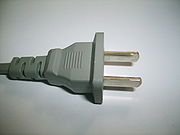
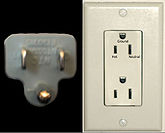
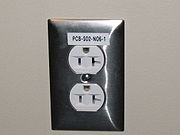


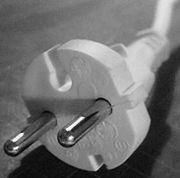







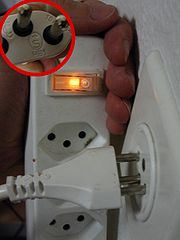

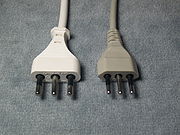
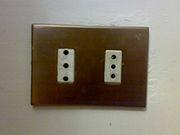

Comments
When commenting on, remember that the content and tone of your message can hurt the feelings of real people, show respect and tolerance to your interlocutors even if you do not share their opinion, your behavior in the conditions of freedom of expression and anonymity provided by the Internet, changes Not only virtual, but also the real world. All comments are hidden from the index, spam is controlled.